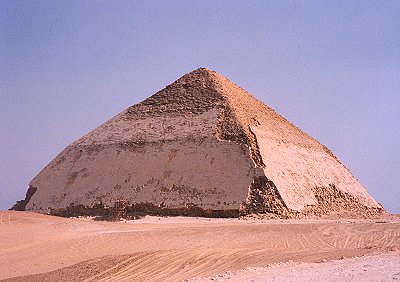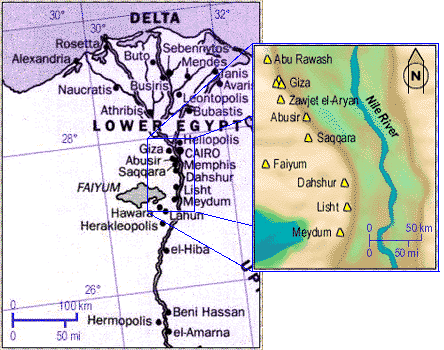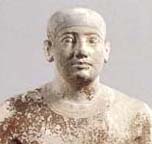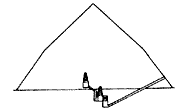
Located in southern Saqqara stand the pyramids of Dhashur. Among them stands the Bent Pyramid. The Bent Pyramid is about 2 km south of the Mastaba Faraoun.

The builder of the Bent Pyramid is thought to have been the Pharaoh Snefru (2680-2565 BC), who was the first ruler of the 4th Dynasty. The Bent Pyramid, is one of three (or maybe even four) pyramids built by the great Pharaoh Snefru in Egypt's Old Kingdom.

His sons were also pyramid builders who helped create these projects. Cheops was one of his sons.
Snefru had the Bend pyramid built as a safe place to rest after he passed to the other side. Egyptians spent years preparing to their deaths.

The Bent Pyramid is rhomboidal shaped.
It unique for two reasons - the first is the angle change. There are two theories for this change. The first is that the builders may have gotten tired and wanted to reduce the volume and to finish faster. Another is that when the pyramid at Maidoun collapsed, the architect lost his nerve and changed the angle. The angle at Maidoun was 52 degrees as is the base of the Bent Pyramid. At the bend, the angle is changed to 43.5 degrees up to the peak.

The first is in the middle of the northern side and is about 12m above the ground. It leads to the upper chamber. The second entrance is on the western side and is just above the ground. It leads to the lower chamber. The floors of both chambers were built 4m deep with small stone blocks.
It is thought that the bent shape of the pyramid was not archetecturally what Sneferu's son set out to built. But due to the weight of the pyramid the original was altered. The pyramid was finally abandoned after 20 years of construction as if was not safe.
The greatest builder of the Pyramid Age was King Snefru, the first king of the Fourth Dynasty, during whose reign the biennial tax levy may have become a more frequent event. As a result, it is difficult to assess the true intensity of Snefru's creative power. He is accorded a reign of twenty-four or twenty-nine years in the ancient king-lists, yet the recent discovery of an inscription mentioning the twenty-fourth occasion of the census suggests he may have reigned as long as forty-eight years, if the taxes were still collected every other year.
But regardless of his total years, his reign is distinguished by the number and sheer magnitude of the works he carried out. The owner of three full-sized pyramids and probably two smaller ones, he shifted one-third more stone - some 3,600,000 cubic meters (4,708,800 cubic yards) of it - than his son and successor Khubu, the builder of the Great Pyramid.
Snefru's reign represents an important period in Egyptian history, a period of transition in art and architecture. It was a time when developments in the rendering of the human form and major advances in the working of stone were crystallized and perfected. To him belongs the credit for the first geometrically true pyramids ever attempted in Egypt, as well as major and long-lasting changes in how the resurrection machine functioned. It was his experiments with its conception and form that set the stage for the remarkable achievements at Giza.
Previously believed to belong to Huni, simply because no one could conceive of one king building so much, the pyramid at Meidum is now recognized as the first of Snefru's projects. Its bizarre shape, the result of later stone-robbing, has earned it the Arabic name 'Haram el Kaddab' or 'The False Pyramid'. It was, however, built as a step pyramid, the only full-sized one after Djoser's to have been completed. Snefru then decided to try his hand at something completely different.
For his second great project, Snefru chose the previously unused plateau at Dahshur further to the north. He selected the site for his pyramid, now known as the 'Bent Pyramid', for obvious reasons. Here was a large flat area with good-quality stone near by and a gorge that could serve as a natural transport ramp from the Nile. It appeared to be very suitable place to build a new eternal abode of a great ruler. This turned out, however, to be a crucial mistake.
The underlying sands and shales eventually proved unable to support the weight of the pyramid, the first to be designed as a true geometric pyramid and one that would have surpassed the height of the Great Pyramid had it been completed as planned. Although various theories have been proposed to explain the curious change in angle which gives the Bent Pyramid its name, the most convincing reason for its shape was the necessity to remedy the cracks and fissures caused by subsidence which began to appear even while this pyramid was being built.
The original plan was to build a true pyramid with a rather steep slope of about 60 degrees, but about half-way through construction the outer casing began to crack. To prevent further subsidence, additional masonry was added to all four sides, reducing the angle of inclination to 54 degrees. Yet it was too late. Fissures in the blocks of the completed internal chambers appeared.
They tried everything: plaster patches, a new lining of masonry, and even imported cedar logs to shore up the walls. It was clear that drastic measures were necessary to save the pyramid, the largest monumental building attempted since the beginning of the Egyptian state, but what more could they do? Ultimately, the architects decided that a radical reduction of the angle and a change in the method of laying the masonry were required. The upper half of the pyramid was completed at an angle of 43 degrees to a height of 105 m (344 ft) with smaller stones laid in horizontal rather than inwardly sloping courses to diminish the weight of the mass. Then Snefru started again.
According to Carl Munck:
The upper body ("bentî) conveys four 180° triangles, for a grand total of (180° x 4 =) 720 degrees.
Each side of the lower body has 360 degrees of corner angles (x 4 sides = ) 1,440 degrees. The whole pyramid then shows 2,160 degrees.
As with any other pyramid, this one has four base corners, but unlike a true pyramid which has four sides, this one shows EIGHT.
Multiplying these demonstrated numbers (2160° x 12 = 25,920)
This product encodes its latitude thusly:
25,920 : 29° : 47' = 19.0168745414" North Latitude
The upper body emphasizes the 180-degree triangle - 180°
There are Nine extremities on the Bent Pyramid; four corners on the ground, four more corners mid-way up, and, of course, its apex. 4 plus 4 plus l - 9
Then its eight sides - 8
Finally, its distinctly different upper & lower bodies - 2
180° x 9 x 8 x 2 = 25,920 (: 29° : 47' = 19.0168745414")
The Bent Pyramid shows us why it is where it is. It was therefore ìbent" before its cornerstones were laid!

It would appear from this that Pharoah Snefru's architects had access to some rather exotic global positioning data.




0 comments:
Post a Comment